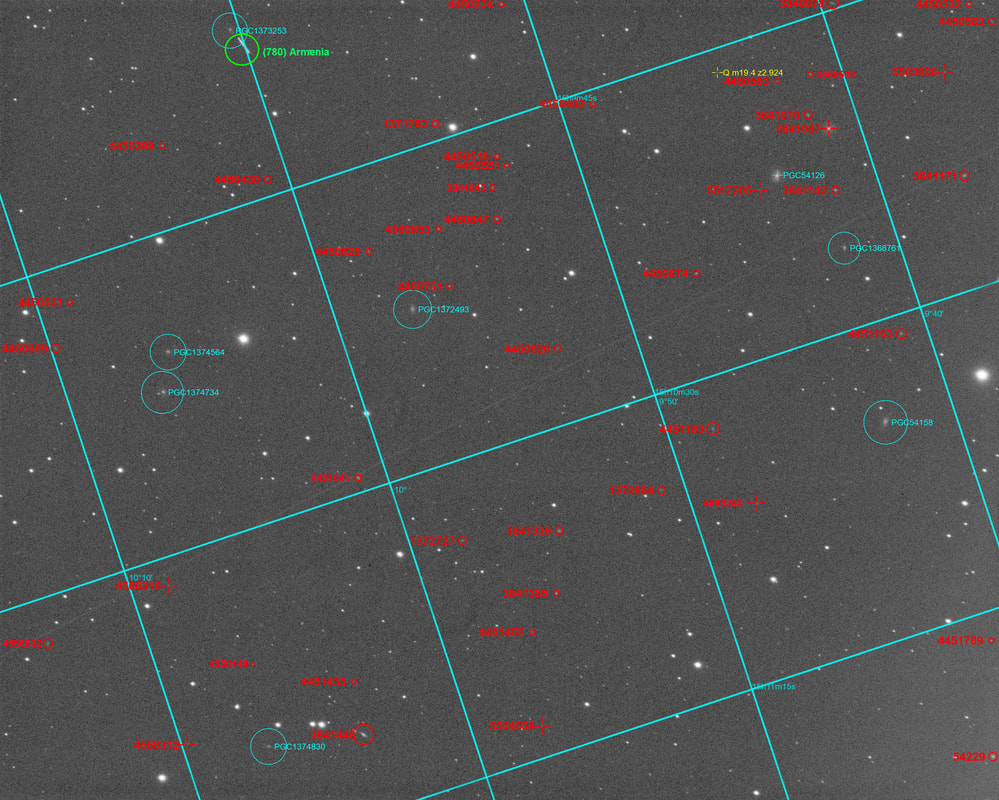Interesting images ...... What are these?
In the main my website is full of colourful pictures of galaxies and nebulae from Deep space as well as lots of useful guides and information. What I have decided it's lacking is a page dedicated to images that are not 'pretty pictures', they will not make you go 'Wow' by just looking at them, but they may be thought provoking or interesting in many other ways.
My main images here will be those that I have taken of asteroids. These images are taken purely to catch a 'dot' in space of an asteroid moving through the frame. They are normally in a field of nothing but stars and are always in black and white. There is no need to take colour data as this is not the point of the photo. But I have been looking more closely and these stars in the frame are often not stars at all...... they are distant galaxies, or quasars or planetary nebula's. Things that are far too faint for me to try to capture to create an image on it's own, but they are there and they are millions of miles away.
My main images here will be those that I have taken of asteroids. These images are taken purely to catch a 'dot' in space of an asteroid moving through the frame. They are normally in a field of nothing but stars and are always in black and white. There is no need to take colour data as this is not the point of the photo. But I have been looking more closely and these stars in the frame are often not stars at all...... they are distant galaxies, or quasars or planetary nebula's. Things that are far too faint for me to try to capture to create an image on it's own, but they are there and they are millions of miles away.
|
This image is a stack of 13x120s and was taken specifically to capture the asteroid (780) Armenia. In the image you can see the following
1) Green - (780) Armenia asteroid (You can watch the video here) 2) Cyan - These galaxies are designated by the PGC catalogue and are all circled. These actually look a little like galaxies as they are slight;y larger and more 'smudgy' than stars 3) Red - These are also galaxies identified by the Hyperleda catalogue with the designation LEDA 4) Yellow - This is the most amazing thing in this image I think...... This is a quasar |
What is a quasar?
These faint targets show up in a few of the asteroid images I have so they are worth explaining at this point before looking at it a little closer.
Quasars are the brightest things in the universe, so the fact that they are so dim suggests how very far away they are in comparison to brighter galaxies. They produce huge amounts of energy as much as a trillion stars in some cases. They are always found near the centre of a galaxy and every galaxy has a supermassive black hole at its centre. When gases flow into a supermassive black hole, the gas becomes very, very hot. This makes it glow. The particles of dust and gas that stream away from the black hole are moving extremely fast. Scientists believe that it is this glowing gas at the edge of the black hole that gives energy and light to a quasar.
How far away are quasars? They range from between 1 billion to 13 billion light years away......
The Sun - 8 minutes and 20 seconds
Mars - 12.5 minutes (average depending on the orbit placement)
Pluto - 263.2 light minutes from Earth
Orion nebula - 1344 light years
M31 Andromeda galaxy - 2.537 million light years
Quasar - Between 1 billion and 13 billion light years
Quasars are the brightest things in the universe, so the fact that they are so dim suggests how very far away they are in comparison to brighter galaxies. They produce huge amounts of energy as much as a trillion stars in some cases. They are always found near the centre of a galaxy and every galaxy has a supermassive black hole at its centre. When gases flow into a supermassive black hole, the gas becomes very, very hot. This makes it glow. The particles of dust and gas that stream away from the black hole are moving extremely fast. Scientists believe that it is this glowing gas at the edge of the black hole that gives energy and light to a quasar.
How far away are quasars? They range from between 1 billion to 13 billion light years away......
The Sun - 8 minutes and 20 seconds
Mars - 12.5 minutes (average depending on the orbit placement)
Pluto - 263.2 light minutes from Earth
Orion nebula - 1344 light years
M31 Andromeda galaxy - 2.537 million light years
Quasar - Between 1 billion and 13 billion light years


